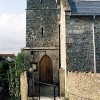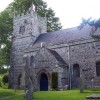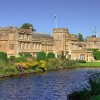The word of God is not preached here anymore. Whitcombe Church is redundant: stripped of its furniture including the pews, although it retains the pulpit from which William Barnes preached his first and his last sermons, it is unlikely ever again to hear voices raised in songs of praise.
Humbled by the nearby magnificent 17th century barn and a farmhouse largely rebuilt in the early 19th century, the Grade I listed church sits in a quiet hollow and has settled on its ancient foundations. Memorials surround it to persons from past congregations who regularly came here to worship. A church has stood on this site since King Athelstan (circa 934) made Whitcombe part of the endowment of Milton Abbey. Seen from the busy road the visitor, after climbing over the stile, will be pleased to find this Norman church open.
Whitcombe is a parish of about 750 acres of largely agricultural land to the south-east of Dorchester and stretching for just two and a half miles along the Dorchester to Wareham road. It is the advance of mechanisation in farming that has been responsible for the declining population. In 1851 there were 61 inhabitants and by the end of the 19th century that number had declined by a third. It is easy to see why the church is redundant: the first census of the 21st century revealed just 10 people living in the parish.
Its fate could also have something to do with the shaky foundations, a problem commented upon in a description of the church written by Mr C.E. Ponting F.S.A., in 1892. He tells us “The building has suffered much from insufficient foundations, there can be no doubt that the rebuilding of parts of the walls were necessitated by this” and he noted that even some of the rebuilt parts were surrendering to the same cause.
Built in squared Portland rubble with dressing of Portland ashlar and some Ham Hill stone, the church consists of a nave and chancel, a west tower and south porch. The nave is 12th century and there are traces of pre Conquest masonry at the west-end. The chancel and south porch were added in the late 15th century and a start was made at the same time on the west tower with the upper stage completed later, about 1596. The roof is modern and covered with tiles and stone slates.
The church retains fragments of two pre Conquest cross-shafts and on the north wall of the nave is a wall painting of St. Christopher carrying Christ, thought to be 15th century and the other is early 14th century arcading. The early 13th century font is of Purbeck marble. Two bells both by John Wallis remain in the church but are no longer hung, both are dated 1610 one inscribed HOPE WELL IW and the other LOVE GOD IW,
The churchyard is partly surrounded by an 18th century brick boundary wall inside of which are 32 monuments the oldest to Melchisadeck Gillet and dated 1680 and there are 18th century memorials to several members of the Spratt family. The most recent burial was in July 1983 and after the church had been declared redundant when 91 year-old Elsie Barnes was laid to rest with her husband James who had died in December 1957.
The church at Whitcombe retired since 1971 is nowadays in the care of The Churches Conservation Trust.



